After looking back last week at the worst players to ever be selected to an MLB All-Star team, now we look at the best players/careers to never be selected to an All-Star team. Same criteria was used to assemble the team as each player has the highest career Wins Above Replacement (WAR) at their position among players who never made an All-Star team. There are two active players and a former MVP on the squad.
Catcher
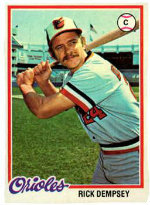
Rick Dempsey 1969-1992
Career WAR: 25.4
Only ten players in history played in more seasons (24) in the Majors than Dempsey. He was an excellent defensive catcher but surprisingly never won a Gold Glove. He debuted at age 19 with the Twins but it would take him nearly ten years to become a regular starting catcher in the Majors.
Why was he never an All-Star?
Dempsey simply was never an elite catcher at any point in his career and he never hit for a high average or much power to get the attention of All-Star managers. His three best seasons according to WAR were 1978, 1980, and 1985. In those seasons he ranked as only the 4th, 6th, and 4th best catcher in the A.L. respectively. Also in none of the three years did have a great first half offensively that would have warranted All-Star consideration. The best first half he had was in ’85 and even then he was hitting just .255/.346/.392. Good numbers for a 35 year old catcher but not good enough to be named an All-Star.
First Base
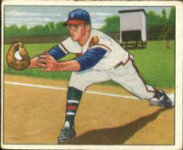
Earl Torgeson 1947-1961
Career WAR: 32.9
Torgeson was known for having an excellent plate discipline (career .385 OBP, finished in Top 10 in walks seven times) and for getting into several fights during his career. He was the rare first baseman with good speed as he stole 133 bases in his career.
Why was he never an All-Star?
Torgeson had only one truly outstanding year and that came in 1950. He led the N.L. in runs scored (120) and per WAR was the second best first baseman in the league to only Stan Musial. No surprise Musial was voted the starter and Hall of Very Good first baseman Gil Hodges was selected as the reserve over Torgeson. At the break Hodges did have a slightly better traditional numbers hitting .291 with 11 HR and 49 RBI to Torgeson’s .275, 11 HR, 46 RBI. It was the second half of the season where he really turned it on hitting .303/.429/.500. He had a good follow up season in ’51 but after that was just a run of the mill first baseman and spent the latter half of his career as platoon player.
Second Base
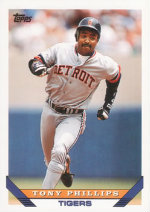
Tony Phillips 1982-1999
Career WAR: 50.8
Phillips was one the best utility men to ever play the game. Second base was his primary position but he also saw extensive playing time at third base, shortstop, and both corner outfield positions. He ranks 38th all-time in career walks and no player has a higher career WAR without ever being named an All-Star.
Why was he never an All-Star?
Phillips is one the most underrated players of all-time I think. He’s not a Hall of Famer by any means but he was Ben Zobrist before Ben Zobrist. Problem for Phillips is when you look at the traditional numbers they didn’t stand out at the time as so much of his value came from drawing walks. He didn’t hit for a great average, not a lot of power, and though he had good speed he wasn’t a big time stolen base threat either. He had a very good peak with the Tigers from 1990-1994 with 1993 being his best year. He hit .313/.443/.398 with 132 walks and 113 runs scored. He actually hit slightly better in the first half of the season and had 42 RBI at the break. His primary position in ’93 was left field but he also played 51 games at second. First looking at the outfielders, the reserves for the A.L. were Albert Belle, Juan Gonzalez, Greg Vaughn, and Devon White. Belle and Gonzalez both had huge numbers at the break while Vaughn also was having a good year and was lone and by far most deserving rep for the Brewers. White though was hitting .289 with 11 HR, 28 RBI, and 19 SB and I seem to recall A.L. manager Cito Gaston getting some heat for picking him. The pick can be defended though with the fact that none of the other reserve outfielders could play center field. As for second base the reserve was Carlos Baerga who was hitting .293 with 15 HR and 63 RBI. Phillips’ problem was that he played a decade or so too early. In the “it counts” era of All-Star Games a utility man like Phillips holds a lot more value for All-Star managers pretending they care who wins.
Third Base
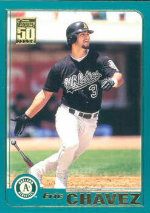
Eric Chavez 1998-present
Career WAR: 37.0
Chavez is one of the greatest defensive third basemen of all-time, winning six straight Gold Gloves from 2001 to 2006. A once promising career was derailed by injuries and is now only a platoon part-time player.
Why was he never an All-Star?
During his prime Chavez was a notorious slow starter which will always hurt a player’s All-Star chances when their first half performance is given so much weight. From 2001 to 2004 on average he hit .258/.336/.486 in the first half of the season compared to .304/.380/.550 in the second half. The starkest contrast in his first and second half numbers came in his best season of 2001 where he hit only .245/.301/.437 at the break and then had a blistering second half posting a .340/.382/.664 stat line. 2002 on the other hand was the exception as he posted better numbers in the first half than second. His traditional numbers at the break were .271, 20 HR, 58 RBI. This was during a time that Red Sox and Yankees fans dominated fan voting and regrettably Shea Hillenbrand was voted the starting third baseman for the A.L. The reserve choices were Robin Ventura and Tony Batista. Oddly enough of those two it was actually Batista was the more deserving player, at least based on first half numbers, and was the lone rep for a terrible Orioles team. Ventura was hitting .283, 7 HR, 36 RBI and a meager .391 slugging pct. But A.L. manager Joe Torre picked one of his players and snubbed Chavez. He was only 24 at the time and a budding star so probably didn’t seem like a huge deal at the time but it ended being his best chance to ever make the team.
Shortstop
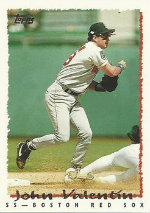
John Valentin 1992-2002
Career WAR: 32.5
Injuries cut Valentin’s career short but he made quite the impact on the mid-90’s Red Sox. He was a very good hitter and defensive shortstop, although he would eventually move to third base to accommodate the Sox new star shortstop Nomar Garciaparra.
Why was he never an All-Star?
In 1995 Valentin had an MVP caliber year and according to WAR he was indeed the most valuable player in the Majors that season. His teammate Mo Vaughn ended up winning the MVP and was one the worst choices of all-time. But we’re not here to discuss the 1995 A.L. MVP voting but to figure out how did Valentin not make the All-Star team that year? Shortstop was not a loaded position yet in the A.L. as this was the year before Alex Rodriguez’s breakout season, Derek Jeter’s Rookie of the Year season, and Garciaparra making his MLB debut. Now Valentin did have a better second half of the season but his first half numbers were still strong hitting .284/.384/.529 with 14 HR and 42 RBI. Cal Ripken was of course the perennial starting shortstop for the A.L. but who was the reserve choice? Gary DiSarcina (career 66 OPS+). Funny thing happened though is that he actually had a really good first half in ’95. Not as good as Valentin mind you but he was hitting .324/.367/.488 at the break. A.L. manager Buck Showalter saw the superior batting average and picked the DiSarcina over Valentin. He did have one more very good year in ’97, now playing third base, but his first half numbers were just solid (.286/.350/.438) and that year he lost out to Jeff Cirillo who was hitting better at the break (.300/.377/.456).
Left Field
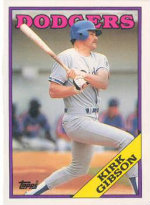
Kirk Gibson 1979-1995
Career WAR: 38.4
Do I really have to talk about him? Can’t I just put Tony Phillips here as the left fielder as well? In any event, among other things Gibson is noteworthy for being the only player ever to win an MVP award yet never be selected to an All-Star team in his career.
Why was he never an All-Star?
Because he sold poison milk to school children.
Okay I’ll look at his case seriously. First and foremost we need to look back at his ’88 MVP season. Gibson isn’t the only MVP who didn’t make the All-Star the year he won it, it’s happened ten times with the last being Jimmy Rollins in 2007 but doesn’t make it any less of an unusual occurrence. Gibson was actually had much better first half than second half that year with an OPS that was 91 points higher. He was hitting .299 with 15 HR, 46 RBI, and 15 SB at the break. Only three outfielders were selected as reserves in ’88 and those being Andy Van Slyke, Willie McGee, and Rafael Palmeiro (yes he was an outfielder at the time). Van Slyke was having a terrific year but both McGee and Palmeiro had sub .800 OPS. Batting average once again trumps all as both were “hitting” better than Gibson. Also didn’t hurt McGee that his manager Whitey Herzog was making the decisions of the N.L. that year. What may have hurt Gibson the most was Vince Coleman being voted as a starter who likely wouldn’t have been selected as a reserve even with Herzog as manager. Now if you go back to Gibson’s days with the Tigers in 1985 he actually better first half numbers than his MVP season hitting .296 with 18 HR and 61 RBI. That year he was passed up for an unimpressive outfield trifecta of Tom Brunansky, Phil Bradley, and Gary Ward. But those three also happened to be the lone reps for their teams so that was just bad luck for Gibson.
Center Field
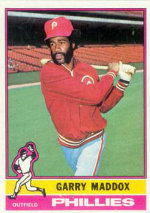
Garry Maddox 1972-1986
Career WAR: 36.7
“Two thirds of the Earth are covered by water. The other one third by Garry Maddox.” – Ralph Kiner
It’s an old, often repeated quote but still a great one. Maddox was one of the greatest defensive outfielders of all-time. He won a Gold Glove every year from 1975 to 1982 but he was never anointed as an All-Star.
Why was he never an All-Star?
Maddox was not a very good hitter for most of his career but he did have two noteworthy seasons with his bat in 1973 and 1976. In ’73 as a member of the Giants he was in just his second season and had a great start hitting .322/.356/.464 with 6 HR, 44 RBI, and 14 SB. There were actually six reserve outfielders on the N.L. team that year, one of them being Willie Mays in his final season which was a lifetime achievement selection. The other reserves were Willie Davis, Manny Mota, Willie Stargell, Bob Watson, and Maddox’s teammate Bobby Bonds. Watson was the lone Astros rep but he was having a fine season, Stargell and Bonds were both putting up monster numbers, and Davis’ numbers were similar to Maddox. The peculiar selection was Mota he was hitting .351 but he wasn’t a full-time player either as he was the longtime pinch hitting extraordinaire for the Dodgers. Maddox should been on the team over Mota but considering we’re five deep on the outfield reserves it was just a tough year to make it. Moving on to Maddox’s career season of ’76 he was hitting .321/.381/.483 with 5 HR, 40 RBI, and 13 SB at the break. This time around he was passed over for Cesar Cedeno, Ken Griffey, Bake McBride, and Al Oliver. The latter two were their team’s only rep and Griffey was hitting .340/.412/.460. Cedeno was hitting .297/.350/.493 with 14 HR, 48 RBI, and 28 SB. This time batting average didn’t win out and instead Cedeno’s better power numbers and probably his SB as well got him the nod.
Right Field
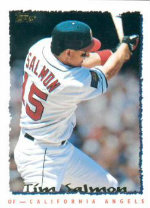
Tim Salmon 1992-2006
Career WAR: 40.8
Salmon played his entire 14 year career with the Angels and is the franchise’s all-time home run leader (299). In fact he hit more home runs than any player never selected to the All-Star game.
Why was he never an All-Star?
Salmon’s best season by far was in 1995. According to WAR he was the third best outfielder in the Majors that season behind only Barry Bonds and Albert Belle. Although the Angels collapsed in the second half it was of no fault of Salmon’s as he hit .364/.436/.650 after the break. His numbers at the break were very strong as well he as he was hitting .291/.423/.530 with 15 HR and 42 RBI. The A.L. reserves that year were Paul O’Neill, Manny Ramirez, and Salmon’s teammate Jim Edmonds. Kenny Lofton was also selected as a reserve but he would start in place of injured Kenny Griffey Jr. and I don’t know if any of the other three were an injury replacement to the roster. Ramirez and O’Neill both had better numbers than Salmon at this point in the season but strangely enough Edmonds did not yet he was selected over his own teammate. The only offensive category of note that Edmonds had an advantage in was RBI (52). I do remember that this was the year that Edmonds was starting to get national attention for his spectacular defensive plays (often on bad jumps) and it was probably what cost Salmon. Other seasons of note for Salmon were 1993, when he was Rookie of the Year, and 1997. I already covered the ’93 reserves and again Devon White’s selection was somewhat defensible but cost another deserving player a spot. 1997 is interesting in that on the final roster there were only two reserve outfielders. David Justice had been voted as a starter but was injured and replaced by O’Neill in the line up but another outfielder was not added as a reserve which left Belle and Bernie Williams as the only outfielders on the bench. Both of them were having slightly better seasons than Salmon and I’m not certain what non-outfielder took Justice’s spot on the roster. It’s tough to say if Salmon was really snubbed that year.
Designated Hitter
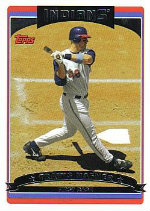
Travis Hafner 2002-present
Career WAR: 25.3
Although injuries have limited him the last several years it’s easy to forget that for a few years there wasn’t a more dangerous hitter in the American League than Hafner. He led the league in OPS+ in both 2004 and 2006.
Why was he never an All-Star?
From 2004 to 2006 Hafner had an OPS+ of 170, only Barry Bonds and Albert Pujols were better. One of the things that worked against Hafner is the fact he is a DH and 2005 was the only year of the three that the All-Star Game was played in an A.L. park. It wasn’t until 2011 that the rule was changed that there would be a starting DH regardless of which league was hosting. Also it is now mandatory a back up DH be selected which wasn’t the case in 2005 either. That’s a very silly rule as anyone can DH but it again would’ve helped Hafner as David Ortiz has been the perennial starting DH for years now. We’ll toss out 2004 as Hafner had only 10 home runs at the break and the game was in an N.L. park so he probably didn’t get much consideration. In 2005 though he was hitting .319/.425/.595 with 18 HR and 63 RBI with the game in an A.L. park yet manager Terry Francona somehow couldn’t find a spot in the roster for him. More galling was that MLB then left Hafner off the fan vote for the final roster spot which ended being won by Scott Podsednik of all people. Hafner followed up that snub with the best year of his career and hit a torrid .322/.461/.650 with 25 HR and 74 RBI in the first half but with the game in an N.L. park they couldn’t find a spot on the roster. This time around MLB did get him on the final player vote ballot but the fan’s instead voted for scumbag A.J. Pierzynski.
Starting Pitcher
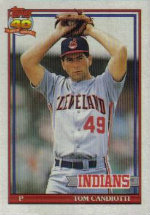
Tom Candiotti 1983-1999
Career WAR: 42.5
You don’t hear Candiotti’s name come up a lot when talking about great knuckleball pitchers but he might have been the most underrated pitcher in the Majors during the late 80’s and early 90’s. From 1986 to 1993 he ranked 5th in WAR among all pitchers.
Why was he never an All-Star?
The biggest thing working against Candiotti was he played on a lot of bad teams during his prime which hurt his win/loss record. Back then it was almost the end all, be all of whether a starting pitcher made the All-Star team or not. His career high in wins was only 16 (1986) and only once did he have a winning percentage above .600 (1988). His most exceptional season came in 1991, splitting the season between the Indians and Blue Jays after a midseason trade, where he finished 2nd in the A.L. in ERA but only finished with a 13-13 record. He had a 2.23 ERA at the break but that did not impress A.L. manager Tony LaRussa enough to put him on the team most likely due to his 8-7 record. Jack McDowell was selected to the team with an ERA nearly a run higher but he also had a more appealing 10-4 record. What probably cost Candiotti was Scott Sanderson with an ERA of near 4 was selected as the lone rep for a historically bad Yankees team. In Candiotti’s ‘88 season where he had his best career winning percentage he was only 7-7 with a 3.50 ERA at the break and didn’t warrant consideration at that point. During those peak years from ’86 to ’93 he was never more than two games over .500 at the break but again wasn’t necessarily all his fault. But reality is also while Candiotti was very good during this time frame, outside of the ’91 season he wasn’t among the elite pitchers of the game.
Relief Pitcher

Mike Timlin 1991-2008
Career WAR: 19.2
Timlin was one of the more consistent relief pitchers during his career. He has a mark he probably wishes he didn’t have in that he pitched in more games (1,058) than anyone to never be selected to an All-Star team.
Why was he never an All-Star?
Like Tony Phillips, Timlin probably would have benefitted from his career just starting a little bit later with the current All-Star selection process. All-Star managers today think they need as many middle relievers as possible to win the All-Star Game. He did though have his best season, according to WAR, under the current selection process in 2005 with his own manager Terry Francona helping pick the teams along with the player’s ballot. Timlin had a sparkling 1.69 ERA at the break and there were six relievers on the A.L. roster that year but half of them (Danys Baez, Justin Duchscherer, Bob Wickman) were the lone rep for their teams so that probably killed any chance he had of making the team. Only twice during his career was he the closer for a team during most of the season (1996 and 1999). He had a very poor first half in ’99 with the Orioles but in ’96 with the Blue Jays he had solid numbers at the break with a 2.57 ERA and 15 saves. A.L. manager Mike Hargrove showed some serious All-Star nepotism by selecting his own closer Jose Mesa to the team despite a near 5 ERA at the break. Mesa certainly had no business being on the team but it’s tough to say that Timlin not making the team was a huge snub either.

